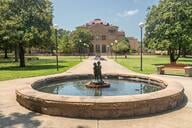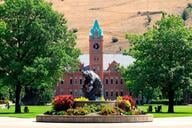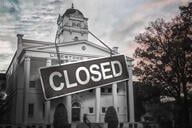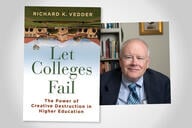You have /5 articles left.
Sign up for a free account or log in.
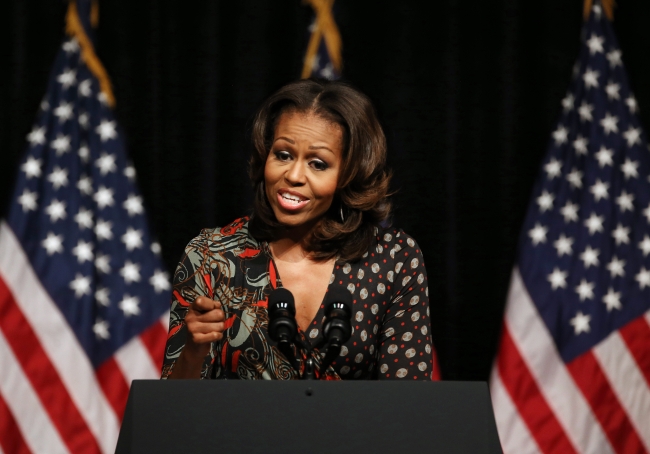
Michelle Obama speaks about higher education at a Washington high school.
Getty Images
WASHINGTON -- Michelle Obama on Tuesday kicked off a new White House push to increase the number of low-income students who apply to and graduate from college.
Speaking to students at a high school here, the first lady drew on her own personal experiences as a first-generation college student who earned two Ivy League degrees to encourage students to set high expectations and take responsibility for their own higher education. She also highlighted the president’s oft-stated goal of having the highest percentage of college graduates in the world by 2020.
The speech marks a shift for the policy portfolio of the president's wife, who has, until now, not weighed in significantly on higher education issues.
But it also charts new territory for the administration on higher education policy. White House officials are interested, according to university leaders who have had discussions with them, in finding ways to elevate -- and perhaps nudge along -- the efforts of public and private universities to better recruit and graduate low-income, first-generation students.
The administration has especially been drawn to the problem of “undermatching” -- that is, when high-achieving low-income students don’t apply to the competitive colleges where they would likely be accepted.
The phenomenon, which was documented in a study last year by the prominent education researchers Caroline M. Hoxby of Stanford University and Christopher Avery of Harvard University, has increasingly gained the attention of higher education researchers and advocates.
And in her speech Tuesday, Obama alluded to the problem of undermatching, though not by name.
She described her experience as a hard-working student at a good high school in Chicago who was ambitious but lacked the additional resources, such as high-quality college counseling, needed to land her a spot at a selective universities.
“I couldn’t afford to go on a bunch of college visits,” she said. “I couldn’t hire a personal tutor. I couldn’t enroll in SAT prep classes. We didn’t have the money.”
“Some of my teachers straight-up told me that I was setting my sights too high,” she continued. “They told me I was never going to get into a school like Princeton.”
Once she got to Princeton, Obama said, she continued to struggle and had to work hard to build a community of support.
“There were times when I felt that I could barely keep my head above water,” she said -- echoing in broad terms a theme she discussed in her senior thesis, which explored, among other things, the challenges of being a black student at Princeton.
Both President Obama and the first lady have previously relayed stories of their own experiences with college in discussing higher education policy issues. For instance, the Obamas, especially during the 2012 campaign, have highlighted their own challenges with student loan debt as the administration pushed for increased funding for federal student aid and lowering the rate on certain federal loans.
The focus on “undermatching,” however, is a new initiative for the administration, which is simultaneously developing a federal ratings system to judge colleges on access, affordability and student outcomes.
Obama administration officials, for the second time this month, met on Tuesday with public university presidents to discuss how to boost enrollment of low-income, academically talented students at the nation’s best institutions.
At Wednesday’s gathering, Gene Sperling, the chief White House economics adviser, and James Kvaal, deputy director of President Obama's Domestic Policy Council, solicited feedback from the university leaders on what they were doing to recruit and enroll low-income students at their institutions. The officials also floated the idea of having colleges set goals for improving their efforts, according to Samuel L. Stanley Jr., the president of the State University of New York at Stony Brook, who attended the meeting.
“The idea is to find some ways to share some of these best practices and come up with some goals we think are achievable,” Stanley said. “They clearly are interested in seeing commitments potentially from universities, and colleges around the country, to see if people can do a better job in addressing these challenges.”
The meeting did not delve into what specific goals would look like, but rather focused on trying to identify best practices in recruiting low-income students and flagging efforts already under way at some universities that might be effective more broadly, Stanley said.
“They asked us to think about what would be appropriate goals, with a recognition that one size doesn’t fit all,” he said. “These are things that fit already into the goals on many of our campuses, so they asked us to come up with some ideas and suggestions.”
The administration officials did raise the possibility that some funding or incentives might be available to support some of the efforts to boost low-income enrollment, but did not offer details on that either, Stanley said.
Sally Mason, the president of the University of Iowa, who also attended the meeting, said that officials discussed their plan to use the president and first lady’s bully pulpit to bring awareness to the issue of access for low-income, first-generation students.
Mason, who is a first-generation college graduate herself, said she welcomes that level of attention to the value of higher education. She is concerned, she said, that public discussion questioning the value of higher education is discouraging disadvantaged students from applying for college.
“It’s been made to sound like college education is out of reach for first-generation college students,” she said. “We need to redouble our efforts to reach as many families as possible to help them understand how it is that you can afford to have a good public higher education. That’s a message that honestly isn’t getting out there the way it should.”
Mason said the administration officials also said Wednesday that the president planned to convene a meeting in December to discuss issues surrounding low-income students’ access to higher education in more depth.

